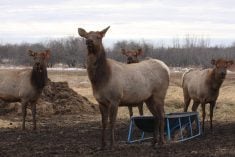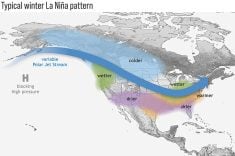Powdery mildew is showing up on the leaves of pea crops in east-central and northern Alberta, raising red flags for growers who saw a massive outbreak of the disease in 2003.
While the infection rate appears to be much lower than the same time last year, conditions are rife for a resurgence of the disease.
“There’s definitely a good chance of it becoming a real concern again this year,” said Alberta Pulse Growers president Don Deaville.
Powdery mildew thrives under the kind of hot, humid conditions that the Prairies received in the first half of July.
Read Also

Container dispute embroils Port of Vancouver
GCT wants to expand its existing container terminal at the Port of Vancouver, but it is running into opposition from the port itself.
Deaville hasn’t seen many growers spraying for the disease in his area of the province near Paradise Valley, but he has heard of farmers in other regions that are “going like crazy” to keep on top of the problem.
Alberta Agriculture crop specialist Karla Bergstrom said powdery mildew was out of control in 2003, especially north of Red Deer.
“We saw very widespread effects of this disease.”
It’s a fungal infection that thrives in weather that delivers hot days followed by dewy nights.
“It can spread like wildfire,” she said.
“You may see it on a few spots on the bottom lower leaves of a plant one day and it could entirely cover your field within three days to a week.”
Bergstrom said plenty of new yellow and green pea cultivars are available that are resistant to powdery mildew, but as evidenced by last year’s outbreak, many producers continue to plant seed saved from older varieties.
Some pea growers who planted the newer resistant varieties last year claim they didn’t work.
Plant damage ranges from stunted growth to hollow or split pea seeds, but the primary concern is how the disease affects harvest.
It reduces the effectiveness of desiccants such as Reglone and Roundup Transorb. The chemicals are unable to penetrate the white growth on the plant, meaning infected pea crops will take longer to dry down, dangerously delaying harvest.
However, concerns that the disease would seriously disrupt the 2003 pea harvest failed to materialize. A long, hot autumn allowed growers to get their crops off before moisture or frost became a problem.
While the number of calls coming into Alberta Agriculture’s Ag-Info Centre are way down, Bergstrom has received reports of the disease in the Warspite, Smoky Lake, Coronation and Peace River regions.
Producers are advised to regularly scout fields for the telltale signs – small, white, mouldy spots that appear on the top surface of leaves on the lower part of the plant.
The spots will eventually join to-gether to form a white or grey powdery dust that gives the crop a light blue or grey hue.
Growers who find powdery mildew should consider applying the fungicides Kumulus DF or Headline. If symptoms persist, a second application may be warranted in seven to 14 days.
Deaville said growers will have to look at economic thresholds to see if they can afford to apply a fungicide, especially with pea prices appearing to be on the way down.















